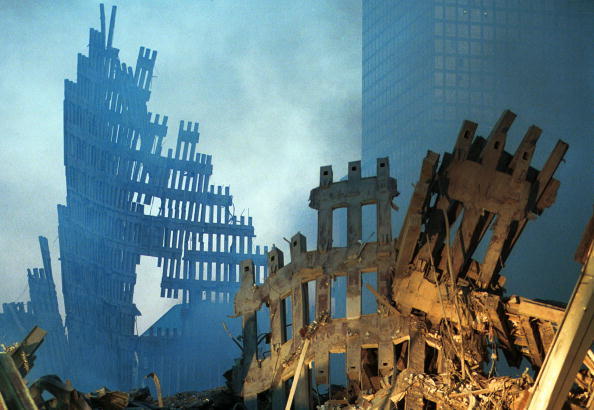Atta’s critique of modernist architecture as a symbol of Western domination. Credit: Chris Hondros/Getty Images

In 1998, the urban planning student Mohammed Atta handed in his masters thesis at Hamburg’s University of Technology. Examining in depth the architecture of Aleppo’s historic Bab al-Nasr district, Atta’s thesis presented a picture of the human-scale “Islamic-Oriental city,” whose winding cobbled streets, shaded souks and alleys carved from honey-coloured stone had been violated by the concrete and glass boxes of liberal modernity.
Le Corbusier’s rectangular forms, the alien importation of French colonial planners, were aped by Syrian planners after independence, Atta’s thesis observed, an architectural symbol of Islamic civilisation’s total subjection to the West. Three years later, Atta’s critique of modernist architecture as a symbol of Western domination assumed its final form when, as the leader of the 9/11 hijackers, he flew American Airlines Flight 11 into the World Trade Center, the glittering towers in the heart of the liberal empire standing as a symbol for Western modernity itself.
The Syrian architect Marwa al-Sabouni, a student and admirer of the late Sir Roger Scruton, likewise sees in the Middle East’s modern architecture a tragic symbol of “a region where even the application of modernism has failed,” where “we traded our close-knit neighborhoods, our modest and inward houses, our unostentatious mosques and their neighbouring churches, our collaborative and shared spaces, and our shaded courtyards and knowledge-cultivating corners, leaving us with isolated ghettos and faceless boxes.”
For al-Sabouni, the anomie of liberal modernity was built into its very architecture, bringing desolation in its wake. An opponent of Islamism, she nevertheless shares the Islamist analysis that the Middle East’s instability is not inherent, but comes from the West’s exporting the structures of liberal modernity to the somnolent peace of Islamic civilisation, setting in train chaos.
“Losing our identity in exchange for the Western idea of ‘progress’ has proved to have greater consequences than we could predict,” she claims. “This vacuum in our identity could not be filled by imported ‘middle grounds’, as was once naively thought; this vacuum was instead filled by horrors and radicalizations, by sectarianisms and corruption, by crime and devastation — in one word, by war.”
It is natural to read a culture’s attitudes to its monuments as expressions of its social health. They are the symbolic repository of any given culture, and deeply imbued with political meaning. When civilisations fall and their literature is lost to time, it is their monuments that serve as testaments to their values, to their greatest heroes and their highest aspirations. Statues, great building projects and monuments are stories we tell about ourselves, expressions in stone and bronze of the Burkean compact between generations past and those to come. As Atta’s thesis states, the architecture of the past is imbued with moral meaning: “if we think about the maintenance of urban heritage,” he wrote, “then this is a maintenance of the good values of the former generations for the benefit of today’s and future generations.”
It is only logical then, for the terminal crisis of liberal modernity to play out in culture wars over monuments, as the fate of a monument stands as a metaphor for the civilisation that erected it. It is for this reason that conquerors of a civilisation so often pull down the monuments of their predecessors and replace them with their own, a powerful act of symbolic domination.
The wave of statue-toppling spreading across the Western world from the United States is not an aesthetic act, but a political one, the disfigured monuments in bronze and stone standing for the repudiation of an entire civilisation. No longer limiting their rage to slave-owners, American mobs are pulling down and disfiguring statues of abolitionists, writers and saints in an act of revolt against the country’s European founding, now reimagined as the nation’s original sin, a moral and symbolic shift with which we Europeans will soon be forced to reckon.
On our own continent, the symbolic, civilisational value of architectural monuments was expressed last year when the world gathered together online to watch Notre Dame in flames. The collective grief that for one evening united so many people was not just for the cathedral itself but for the civilisation that created it, a sudden jolt of loss and pain that came with the realisation the skill and self-belief it took to erect it had vanished forever.
Like Dark Age farmers tilling their crops in the crumbling ruins of a Roman city, we realise we are already squatting inside the monuments of a lost and greater civilisation, viewing the work of our forebears with the wonder and sadness of the Anglo-Saxon poet of The Ruin:
This masonry is wondrous; fates broke it
courtyard pavements were smashed; the work of giants is decaying.
Far and wide the slain perished, days of pestilence came,
death took all the brave men away;
For many observing from outside liberalism, the current iconoclasm of the West is just such a cautionary tale of civilisational collapse. “Statues are being toppled, conditions are deplorable and there are gang wars on the beautiful streets of small towns in civilized Western European countries,” Hungary’s defiantly non-liberal leader Viktor Orban remarked in an interview last week, “I look at the countries advising us how to conduct our lives properly and I don’t know whether to laugh or cry.”
In contrast, in a recent speech to mark the centenary of the hated Treaty of Trianon, Orban specifically cited the historical monuments of the Carpathian region as a testament to the endurance of the Hungarian people throughout history: “the indelible evidence, churches and cathedrals, cities and town squares still stand everywhere today. They proclaim that we Hungarians are a great, culture-building and state-organising nation.”
It is notable that this speech, laden with architectural metaphors, saw Orban for the first time situate Hungary in a separate Central European civilisation outside the West, adopting the language of anti-colonialism in a marker, perhaps, of his shift towards China as a geopolitical patron. Raging against the “arrogant” French and British and “hypocritical American empire”, Orban claimed that “the West raped the thousand-year-old borders and history of Central Europe… just as the borders of Africa and the Middle East were redrawn. We will never forget that they did this.” But these days are over, Orban exulted: “the world is changing. The changes are tectonic. The United States is no longer alone on the throne of the world, Eurasia is rebuilding with full throttle… A new order is being born.”
It is striking, and meaningful, that the self-conscious civilisation states rising to challenge the collapsing liberal order express their neo-traditionalist value systems in reimagined forms of their pre-modernist architecture, with stone and brick giving concrete expression of the ideal.
In Budapest, Scruton’s city “full of monuments” where “in every park some bearded gentleman stands serenely on a plinth, testifying to the worth of Hungarian poetry, to the beauty of Hungarian music, to the sacrifices made in some great Hungarian cause,” Orban is engaged in an ongoing project to erase the modernist architecture of the communist era. The concrete boxes of the rejected order are now shrouded with neoclassical facades and the long-demolished monuments of the glorious past are being re-erected stone by carved stone.
In Russia, Putin’s new Military Cathedral, an archaeofuturistic confection fusing Orthodox church and state in an intimidating expression of raw power, symbolises the country’s apartness from collapsing liberal modernity. The cathedral is a symbol of a civilisation that links its present with its past and future, expressed by Putin in overtly Burkean terms in his recent essay on the Second World War as the “shared historical memory” that foregrounds “the living connection and the blood ties between generations”.
Erdogan’s Turkey similarly expresses its desire to return to its imperial heyday in the elaborate mosques, palaces and barracks in neo-Ottoman style springing up across Turkey itself and its former imperial dominions. In architecture as in political order, the stylings of modernity already seem old-fashioned and stripped of all vitality, the sunlit optimism of the Bauhaus degenerated over one bloody century to the vision of Grenfell Tower in flames.
Like liberalism, the architecture of the postwar order conquered the world, for a time, and is now being rejected by the liberal order’s challengers in favour of the styles that immediately preceded modernity, a civilisational kitsch rejected by al-Sabouni as merely “mimicking the creations of our ancestors”.
In a recent essay, the influential software engineer and thinker Marc Andreesen urged the West to start building again, to recover civilisational confidence, but what should we build? What does our architecture reveal about our political order, in the greater West and here in Britain? What are the greatest recent building projects of our times? Perhaps the glass and steel skyscrapers, temples to our financialised economy, that dominate our capital? The Nightingale hospitals, hurriedly converted from conference centres to deal with the mass casualties of a disease of globalisation?
Perhaps the airport is the fullest architectural expression of liberalism: the liminal symbol, both within the nation state and outside it, of global travel and optimism; a temple of bored consumption where the religions of the pre-liberal order were tucked away, all together, in the bland anonymity of the prayer room; until, that is, Mohammed Atta’s blowback to globalisation soured this post-historical dream, forcing the architecture of liberalism back to its early roots in Bentham’s surveilled and paranoid Panopticon.
The problem, at heart, is we can take down our monuments but have nothing to replace them with. As Scruton notes, monuments “commemorate the nation, raise it above the land on which it is planted, and express an idea of public duty and public achievement in which everyone can share. Their meaning is not ‘he’ or ‘she’ but ‘we’” — but perhaps there is no We any more, with the nihilism of the American mob an expression of a far deeper malaise.
It is surely no accident that this is a moral panic driven by millennials, an evanescent generation without property or progeny, barred from creating a future, who now reject their own past in its entirety. This is the endpoint of liberalism, trapped in the eternal present, a shallow growth with no roots from which to draw succour, and bringing forth no seeds of future life.
For Scruton’s pupil al-Sabouni, the salvation of Islamic civilisation is to be found in an architecture rooted in its past, where, she states, “we must be sincere in our own intentions toward our own identity. We must realise the desire to regain it in order to regain peace. And in order to do so, we simply have to do exactly what any dedicated farmer does to a plant: cultivate the roots and carefully prune the branches.”
But a civilisation that uproots itself will soon wither and die. Able to destroy but not to build, the fading civilisation of liberalism is now a grand, crumbling old edifice whose imminent collapse is wilfully ignored by its occupants, because they have too much invested in it, and can’t imagine what can possibly replace it. But as its unstable masonry keeps falling onto the streets below, the risk of a more spectacular, uncontrolled collapse gathers every day.










Join the discussion
Join like minded readers that support our journalism by becoming a paid subscriber
To join the discussion in the comments, become a paid subscriber.
Join like minded readers that support our journalism, read unlimited articles and enjoy other subscriber-only benefits.
Subscribe